Table of Contents Hide
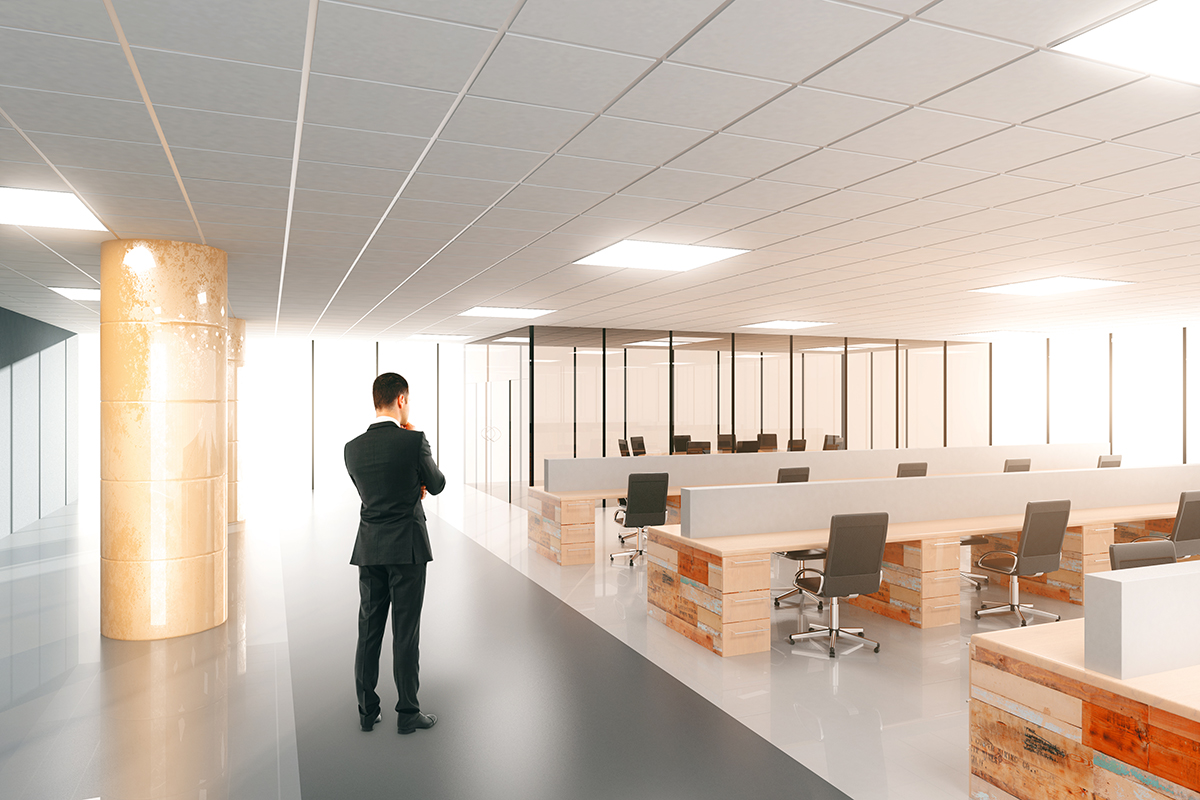
What Is a Troffer Light
Troffers are general-purpose luminaires designed to satisfy the requirement of a wide range of visual tasks in an interior space. They may also be used to provide ambient lighting that fills spaces with a soft level of overall light, making navigating a space visually comfortable, and allowing other basic visual recognition. Troffers are generally designed as recessed light fixtures that are configured to be flush with the ceiling. In office buildings, schools, and healthcare facilities, grid ceilings are often provided to serve as a false or secondary ceiling (also called a "dropped ceiling"). They are hung below the structural ceiling of the building and hide HVAC ducts, pipes, electrical wiring and the like that are installed within the plenum space. Troffer fixtures are secured in the drop ceiling through lay-in or clip-in installations.Size
Drop ceilings typically have square openings into which ceiling tiles are integrated to produce a finished ceiling for a space. The cell sizes vary slightly in different markets and so do the sizes of recessed troffers. In the United States and its neighboring countries, the cell size of most standard T-bar grid ceilings is 2 by 2 feet (610 mm x 610 mm), and light fixtures are recessed into the square cell or a rectangular opening which is 2 by 4 feet (610 mm x 1,220 mm) by size. Recessed troffers are designed accordingly with a slightly smaller size: 603 mm x 603 mm and 603 mm x 1212 mm for 2' x 2' and 2' x 4' ceiling openings respectively. In China and most European countries, the cell size in the suspension grids is 600 x 600 mm, and the recessed fixtures are 5 mm smaller at 595 mm x 595 mm or 595 mm x 1195 mm. In Germany, the cell size in the suspension grids is 625 mm x 625 mm and the square troffer size is 620 mm x 620 mm. Recessed troffers are also available in linear shapes (4"-12" wide, e.g. 1' x 4').Lighting Technology
Troffers were previously the realm of fluorescent lamps which produce light through gas excitation and fluorescence of a phosphor coating inside the glass tube. Notwithstanding their advantages over incandescent and halogen bulbs, fluorescent lamps have a number of problems, including relatively low efficiency, high operating voltages, short life expectancy, poor color quality, emission of ultraviolet (UV) light, cold weather operation, and the use of fragile glass and environmentally unfriendly mercury. As such, fluorescent troffers are rapidly falling out with the advent of solid state lighting based on light emitting diode (LED) technology, which addressed virtually all the limitations of fluorescent lighting.LED technology profoundly changed the way light was generated. In LEDs, light, as result of combined electroluminescence and photoluminescence (fluorescence), is emitted from a block of semiconductor, rather than from a glass tube or bulb. The semiconductor device is designed with a p-n junction (active layer) formed between epitaxial layers. When a forward bias is applied across the epitaxial layers, electrons will drop down from the conduction band of the n-doped epitaxial layer and recombine with holes from the valence band of the p-doped epitaxial layer in the active layer. The recombination releases radiant energy in the form of photons which usually have a FWHM value in the range of from about 15 nm to about 30 nm. The monochromatic light emitted by the diode is further converted to a broadband white light through phosphor down-conversion within the device package. While the upfront cost of an LED system is higher than that of fluorescent systems to various extents, the benefits that come with LED lighting far outweigh legacy lighting technologies.
- The energy conversion efficiency of LEDs now approaches 50%, which is 3-4 times the luminous efficiency of fluorescent lights, and promises even higher percentages. By the very nature of their design and operation, LEDs are directional light sources. The direct nature of LEDs allows light fixtures to achieve a high system optical efficiency (90% to 95%), which is impossible with conventional light fixtures.
- LEDs can be designed to produce a spectral power distribution (SPD) more uniformly spread throughout the visible spectrum for excellent color rendering.
- A precisely controllable spectral characteristic of the radiant energy allows LEDs to emit light with any correlated color temperature (CCT).
- Unlike fluorescent technologies that have restricted controllability and dimmability as they are limited by the specifications of their ballasts, LEDs are fully dimmable and their light output can be controlled using phase, analog and digital dimming technologies.
- The nearly instantaneous response to input from switches, sensors, or mobile devices make these semiconductor devices well suited to application-specific controls, smart lighting, and the Internet of Things (IoT).
- Under optimal thermal management, LEDs can operate for a considerably longer time as compared to a fluorescent light source.
- Moreover, the solid-state nature of LEDs results in excellent resistance to shock and vibration, thereby contributing to a long operating life.
Design and Construction
Troffers used to be lamp-based luminaires that incorporate one, two, or three T12, T8, or T5 linear fluorescent lamps (four is rare). 2' x 2' troffers may also use U-bend fluorescent lamps or compact fluorescent lamps. These light fixtures were later on retrofitted by LED tubes and LED bulbs having the same form factors with the original light source. Modern troffers are integrated performance luminaires that mount LED modules onto the metal housing. The performance of the troffer is derived from the light source in conjunction with the luminaire's optical system. The beam distribution of both the lamp-based and integrated troffers comes from the distribution of the light source by an optical system such as a reflector, refractor, or diffuser. However, integrated luminaires are capable of delivering highly efficient and precisely controlled optical distributions that are not impossible with lamp-based luminaires. Integrated design also reduces physical volume of the luminaire while allowing more efficient thermal management of the LEDs by employing the entire housing for heat sinking. Troffers come in a variety of designs, resulting in distinctions in terms of luminaire efficiency, glare control, visual appearance, and cost. The most common types of troffers are volumetric troffers, parabolic troffers, diffused/lensed troffers, and edge-lit LED panel lightsVolumetric troffers
Volumetric troffers are a type of "reflected direct" luminaires that make use of light reflecting off the inner surface of a recessed housing from concealed or obscured sources. These luminaires feature a center-basket (or dual-basket) lens that hides light source from direct view and directs light onto the upper reflector surface. The center basket that hosts light tubes is usually made of perforated metal backed with diffuse acrylic. The integrated type troffers use linear modules of reflow soldered discrete LEDs. An opaque basket, which is usually an acrylic lens with refractive optical elements, eliminates pixelation and delivers a low-glare, diffused light distribution. The upper reflector which is die formed from cold rolled sheet steel is commonly a smooth surface with a matte, high-reflectance finish which creates a comfortable visual transition from the lens to the ceiling plane. Volumetric illumination balances the delivery of horizontal and vertical illuminance, thereby reducing shadows, improving spatial rendering and increasing the perceived volume of the space. The optical design of volumetric troffers creates a balance of luminaire efficiency and visual comfort, resulting in lighting quality and architectural aesthetics that are generally preferred over that created with parabolic troffers.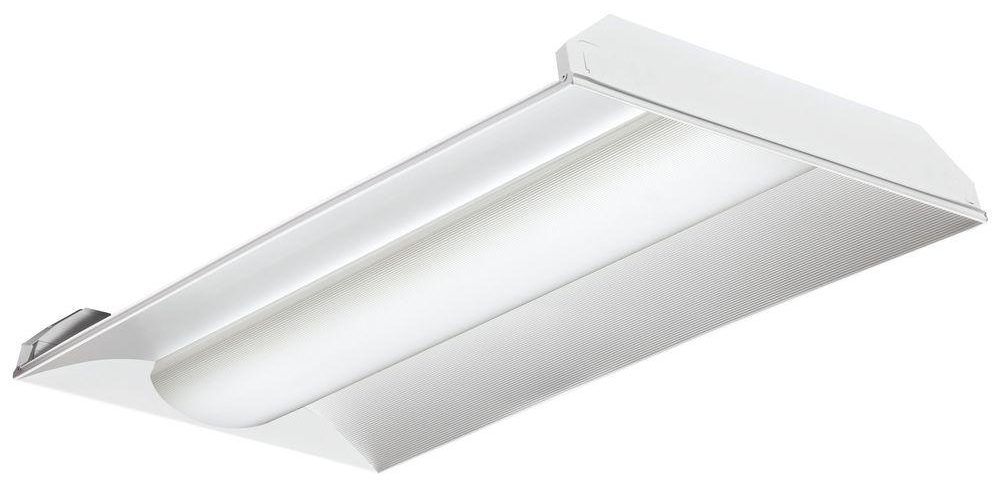
Parabolic troffers
Parabolic troffers feature a grid of parabolic louvers that form an array of cells with size ranging from 1.27 cm x 1.27 cm (0.5' x 0.5') to almost 30.48 cm x 30.48 cm (12' x 12'). The blades of parabolic louvers provide a physical cutoff angle which is the angle from vertical of a line drawn from the bottom of a parabolic cell to the top of the opposite. For precise cutoff, the physical cutoff should be identical with the optical cutoff angle which is determined the reflective curve of the parabolic cells. Parabolic louvers of the smaller cell types are usually injection-molded plastic vacuum-metallized with aluminum. Parabolic louvers of the larger cell types are often made from aluminum sheets, anodized prior to forming. The louvers can be surface finished to provide various degrees of specularity. A specular finish enables parabolic cells to control light output precisely so that almost no light is emitted above the cutoff angle. This also makes the louvers appear completely dark when viewed at a distance and prevents images from appearing in VDT screens. Semi-specular or white finishes are used to brighten the appearance of the troffer thus making space feel brighter. However, high luminance as a result of brighter surface finish may show up as reflections in VDT screens. Parabolic louvers had been designed for lamp-based systems and are being phased out in favor of design with integrated cell arrays where LEDs nestle.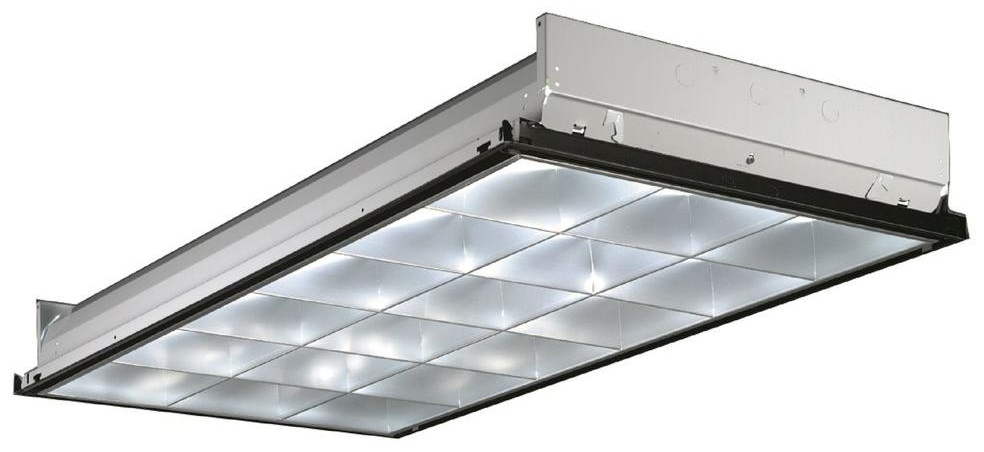
Diffused/lensed troffers
Diffused/lensed troffers are direct-lit luminaires that use either opal diffusers or refractive lenses to create smooth and uniform light emissions, or to avoid unwanted glare. They find applications where low cost is paramount or where an enclosed fixture is required. Diffusers with evenly scattered penetration (opal) are used to distribute luminous flux from light source evenly to all directions thus does not create an image of the light source. However, the radiation pattern of LEDs creates hot spots that require a high level of diffusion to reduce. This will cause large amounts of scattering loss and compromise light extraction efficiency. The photometric distribution of the light may be controlled with a lens that incorporate a series of small prisms - basically this is a refractor. The prismatic configuration is designed to reduce the luminance of the luminaire in the near-horizontal viewing angles between 45° and 90° from vertical. Diffusers and lenses are injection-molded from polycarbonate (PC) or polymethylmethacrylate (PMMA or acrylic).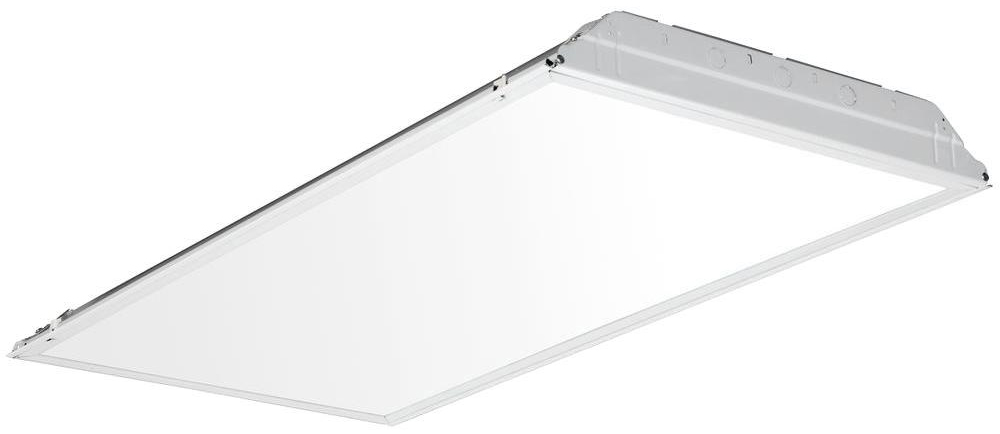
Edge-lit LED panel lights
Edge-lit LED panel lights provide a revolutionary solution to replace incumbent, inefficient fluorescent fixtures as well as to eliminate the harshness of LED light. LEDs are embedded along the edge of an aluminum frame and emit light through a light guide plate (LGP) made of PC or PMMA. The light guide transports light by means of total internal reflection (TIR) and then extracts, distributes light uniformly towards a high-transmittance diffuser, which further scatters the light rays producing a wide radiation pattern and spreads the light out evenly across the entire span of the panel. Edge-lit LED luminaires deliver a fully luminous panel of soft, visually comfortable light with incomparable illuminance uniformity. A clean, modern look and the ultra-thin profile makes them a perfect option for applications that require general lighting to blend into contemporary architectural designs.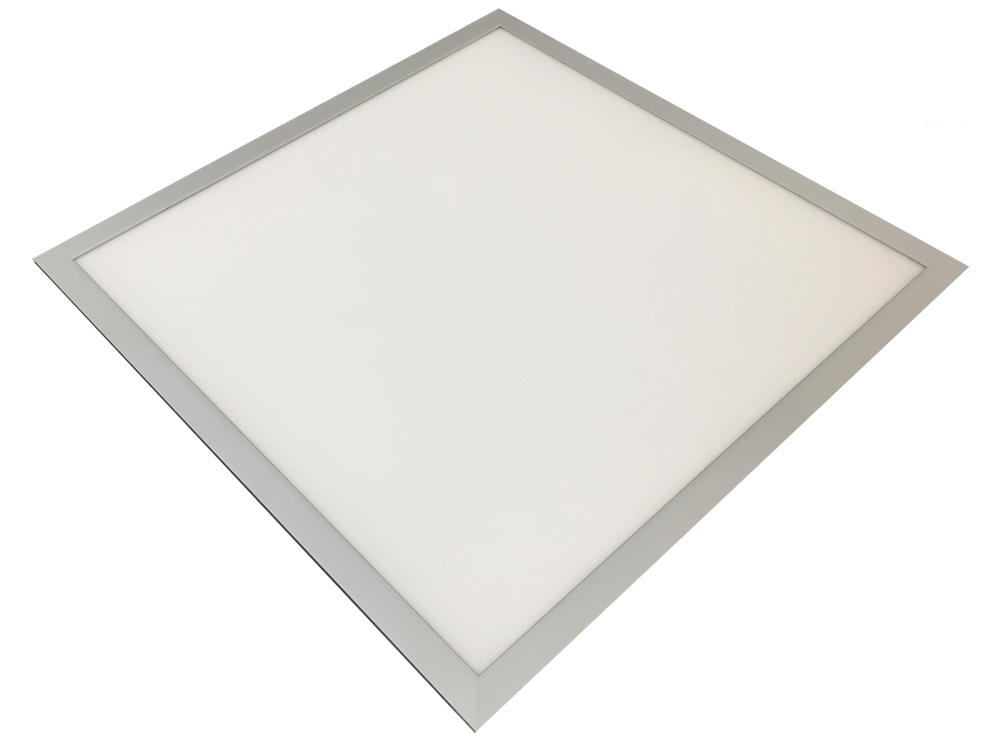
Light Source
Mid-power LEDs are the usual choice for general lighting applications where a high density of light is not required but uniform illumination, high efficacy and low cost are crucial. Before the widespread adoption of chip scale package (CSP) LEDs which are less prone to temperature-dependent failures and have high drive current capability, the performance and lifespan of LED troffers are severely affected by the undependable plastic leaded chip carrier (PLCC) packages. PLCC-based SMD LEDs have an attractive initial lumen/watt because of the use of the highly reflective plastic housing and silver plating. However, these LED packages are inheretly unreliable. The plastic housing has very limited thermal tolerance. Driving the LEDs with an excessively large current may cause a wire bond breakage due to electromigration. The sliver plating of leadframe has poor chemical stability especially against sulfur contamination.As a result, PLCC packages are highly susceptible to accelerated lumen depreciation and color shifts under the conditions of high operating temperature, high current density, high humidity, or corrosive atmosphere. There has been some improvement in thermal stability and package reliability. Rather than using polyphthalamide (PPA) or polycyclohexylenedimethylene terephthalate (PCT), high performance SMD LEDs use thermally enhanced epoxy molding compound (EMC) as the housing material and are designed with Quad Flat No-lead (QFN) anode/cathode pads. The EMC housing offers an improved resistance to discoloration at higher operating temperatures and thus holds off the onset of lumen degradation and chromaticity shift. The QFN design improves heat extraction efficiency and interconnect reliability.
Thermal Management
The ultimate goal of LED thermal management is to ensure that the light source receives minimal thermal stresses and thus it performs optimally over the lifetime of the product. Keeping the LED junction temperatures below the maximum rated temperature is critically important to achieve the reliability and high ROI expected from LED lighting. Troffers have a large housing, which simultaneously serves as the heat sink. The larger the surface area of a heat sink, the greater the natural convection of the waste heat into the surrounding atmosphere. Thermal management for LED troffers focuses on efficient heat transfer from the semiconductor junction of LEDs to the luminaire housing. The interface between the LED module and heat sink surface must provide a sufficient contact area for thermal conduction. The drive current is also a variable that should be considered in thermal management. When a higher drive current is applied to LEDs for a higher lumen output, there's also an increase amount of heat generated in the semiconductor packages. As such, the thermal transfer path must be dimensioned to equal the applied power load.Color Stability
Among all LED failures that occur on LED troffers, color shifts (or chromaticity shifts) can be a terrible nuisance. While minor color deviations do not affect the practical use of LED luminaires, a dramatic shift toward the monochromatic blue, yellow, green, or red direction can mean the end of the luminaire's functional life. The ability of LEDs to maintain its spectral power distribution over time depends on package materials and construction. PLCC mid-power LED packages undergo a variety of chromaticity shift mechanisms. The discoloration of reflective package sidewall may result in a blue chromaticity shift. Oxidation of exposed lead frames, an increase in phosphor quantum efficiency, and operating the phosphor above the saturation flux level will also cause a shift towards the blue direction. Cracking or delamination of phosphor-binder layer in cool white packages with a YAG:Ce phosphor and discoloration/oxidation of the lenses can lead to a yellow shift. Chromaticity shifts in the green direction are due to chemical changes in the phosphor. A red shift can be observed when there's a reduction in the emissions from green phosphors in warm white LEDs.To reduce the probability of color shifts, the use of LED packages with improved thermal stability is a prerequisite. Cheap mid-powder LEDs can exhibit a rapid shift in the blue direction because of the poor resistance to thermal degradation and photo-oxidation of the housing material (PPA, PCT) used in these packages. Discoloration of the plastic housings cannot be tolerated in LEDs since it leads to color shifts as well as depreciation in light output. Since most chromaticity shift mechanisms are temperature-dependent, thermal management should be prioritized in system design. A high ingress protection (IP) rating is required for troffers used in high humidity environments. Moisture can penetrate into the bulk of lens and encapsulant, causing delamination at the chip/phosphor interface due to hydro-mechanical stress. The moisture presence in packages can accelerate the kinetics of yellowing of plastic housing.
Color Temperature
A light source can be characterized by its color temperature. Correlated color temperature (CCT) is a metric that defines the color appearance of the light source. Color temperature is an important aspect of lighting because the composition of light it is related to not only affect visual perception, but also can trigger a wide range of emotional, psychological and physiological responses in humans. Most commercial applications in North America and many European countries use light sources of 3500 K to 5000 K. In many parts of the world, e.g. China, India and Mexico, however, color temperatures for office, school, hospital and institutional lighting are on the cool side of the Kelvin scale (6000 K - 6500 K). While there're no guidelines against the use of light source of extremely high CCTs in interior lighting applications, the biological effect and photobiological safety of light are usually ignored and the preference for bluish white light is the dreadful heritage of fluorescent lighting. On the other side, lighting manufacturers are discouraged to produce low CCT lighting products. This because the lower the CCT of a light source, the lower the luminous efficacy of the light source. The highest efficiency LEDs tend to be at the coolest end of the spectrum. Lower CCT LEDs generate more Stokes heat during phosphor down-conversion, which adds to the cost of thermal management.In spaces typically used during the day, it makes sense to use a neutral white (around 3500 K) or cool white (under 5300 K) light source. Compared with warm white light, higher CCT light creates a daytime feeling and contributes to better visual acuity because it causes the pupils to contract. Nevertheless, the inherent science of using higher CCT light during working hours and the school day is that the higher the CCT, the more the short wavelength (blue) radiation. High intensity short wavelength radiation stimulates the intrinsically photosensitive retinal ganglion cells (ipRGC) photoreceptors. ipRGCs work through the suprachiasmatic nucleus (SCN) to suppress the secretion of melatonin, a sleep hormone, and enhances dopamine, serotonin, and cortisol production. Exposure to blue-enriched white light heightens sensations of pleasure, encourages alertness, raises concentration levels, increases motivation and commitment, and improves muscle coordination.
In general, the CCT of interior lighting should not exceed 5300 K which is the approximate color temperature for noon sunlight. The percentage of blue in the white light of CCTs around 4000 K is sufficiently high to stimulate ipRGC photoreceptors for a high level of alertness, efficiency and productivity during the working hours. Hospitals and offices typically require artificial lighting throughout the day and the operating time often extends into the evening. Prolonged exposure to optical radiation with an excessively high CCT may disrupt circadian rhythms. The risk of blue light hazard increases with the CCT of light. Although light source of 6500 K is considered safe in most applications, high radiance, short-wavelength light should be avoided in environments such as educational facilities where children are present because the lens of a child's eye filters blue light (400 - 500 nm) less efficiently than an adult's lens.
Color consistency is not critical in general lighting applications but still requires moderate control in order to avoid noticeable color variations from fixture to fixture (color uniformity), or within the beam of light (color angular uniformity). This specification should be monitored when a large number of LED troffers are to be installed in an open plan office. Depending on the application, LEDs used in troffers are binned to a 6- to 8-step MacAdam ellipse tolerance (or 6 - 8 SDCM). The smaller the MacAdam ellipse, the tighter the tolerance of color variations but the higher the cost of LEDs.
Human Centric Lighting
The increasing awareness of the biological effects of light on humans is driving the demand for human centric lighting (HCL) systems that allow lighting to adapt to the cycle of natural sunlight or individual needs. People nowadays hardly get any natural daylight but are exposed in fixed, high CCT light that is very likely to disrupt circadian rhythms. HCL-enabled troffers employ tunable white technology to dynamically mix their output (using LEDs with two or more CCTs) to generate the desired intensity and color. With the ability set the CCT to any value between 2700K and 6500K and dim the system from 0% to 100%, tunable white LED troffers bring the dynamics of natural daylight into offices, patient rooms and schools. HCL systems can be programmed to mimic the changes in irradiance and spectrum of sunlight over the course of the day and help synchronize human biological clocks that control circadian rhythms to the outside world. In addition to promoting health and wellbeing through adaptive circadian lighting, these systems can also be used to evoke particular physiological and psychological responses that support moods and performance.
Color Rendition
Color rendition refers to the ability of a light source to reproduce the colors of various objects faithfully. To achieve excellent color rendition, the light source must produce a sufficient amount of radiant power at all wavelengths of the visible electromagnetic spectrum (typically from 380 to 780 nm). However, LEDs must undergo photoluminescence (phosphor down-conversion) to achieve broad spectrum white light. The down-conversion process results in loss in radiant energy (Stokes loss). The more the short wavelengths are down-converted, the lower the optical power because of the Stokes energy loss. The increase in longer wavelength radiant energy in the light spectrum leads to a reduction in luminous efficacy of radiation (LER) due to the low eye sensitivity over the longer wavelength light. This explains why lighting manufacturers are reluctant to offer high color rendering luminaires for general lighting applications.Luminous efficacy often outweighs color quality in general office lighting. LED troffers typically use LEDs with a minimum color rendering index (CRI) of 80 which is tolerable but can lead to color distortion because of the missing wavelengths. In retail outlets, hospital exam rooms, laboratories, studios, classrooms, and applications where color discrimination is important, luminaries with a CRI of 90 or greater should be used. In these applications, the color rendering of the additional six saturated colors in the CRI system (R9 to R14) should be considered as well. The general color render index Ra calculates only the special CRI of the first eight CRI test colors, all of which have low to moderate chromatic saturation. Among the six saturated test colors, R9 is often cited as it shows the response with deep reds. In general, a minimum R9 value of 25 is required for applications where rendering of saturated colors is important.





































